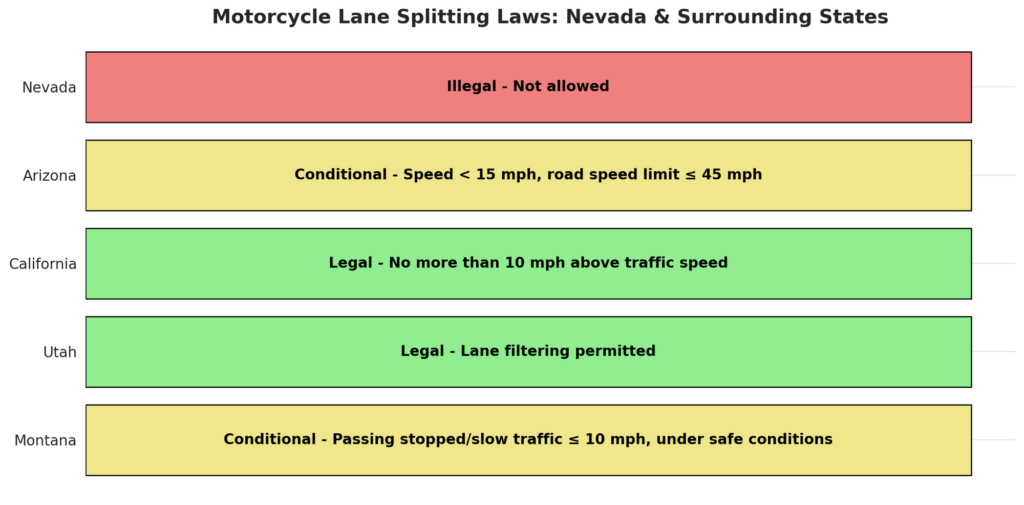Navigating the aftermath of a motorcycle accident can be daunting, especially when factoring in legal complexities around unlawful lane-splitting in Nevada. Questions around fault, liability, penalties, insurance, and pursuing potential injury claims quickly arise.
| Topic | Key Takeaways | ||
| Lane-Splitting Legality | – Expressly illegal in Nevada – Carries fines and license penalties | Comparative Negligence Laws | – Nevada has modified system – Contributory negligence can reduce claim payouts |
| Determining Liability | – Complex process – Based on crash evidence analysis | Settling Injury Claims | – Demonstrating damages is key – Attorney navigation advised |
| At-Fault Driver Penalties | – Traffic citations – Increased insurance premiums | Not-at-Fault Driver Options | – Pursue injury claim – Recover repair costs from insurer |
| Steps for Motorcyclists | – Seek medical care – Document evidence – Follow post-crash checklist | Steps for Drivers | – Render aid – Provide statement – Contact insurer |
Understanding Lane-Splitting and Nevada Laws
Illegality of Lane-Splitting in Nevada
Lane-splitting—the practice of motorcyclists riding in the space between lanes of vehicles—is strictly prohibited under Nevada state law. This blanket ban encompasses all public roads, highways, and interstates across the state. Unlike neighboring California, lane-splitting of any kind is considered illegal.
The illegality stems from statewide statutes prohibiting operation of motorcycles between lanes or rows of vehicles. Fines up to $250 may be imposed for traffic violations.
Comparisons to Neighboring States’ Regulations

Nevada occupies a middle ground regarding lane-splitting regulations among nearby states:
- California: Explicitly permits lane-splitting when done safely.
- Arizona: No definitive legal stance but generally considered illegal.
- Utah: Completely outlawed for motorcyclists.
This variance means extra caution is required when crossing state lines where restrictions differ.
Safety Concerns and Risks
Multiple studies confirm greater risks for motorcyclists splitting lanes compared to riding fully within lanes:
- Over 4x higher injury severity risk at road speeds above 30 mph
- 3x higher likelihood of fatality in lane-splitting accidents
Key dangers include:
- Sideswipe crashes with vehicles changing lanes
- Losing control when vehicles brake suddenly
- Higher crash impact speeds
Lane-splitting inheritance endangers motorcyclists and nearby vehicle occupants.
Historical Evolution of Nevada’s Lane-Splitting Laws
While explicitly outlawed for decades, the debate around amending Nevada’s lane-splitting prohibition has intensified recently.
- In 2015, Assembly Bill 236 sought to permit lane-splitting under certain speed thresholds. It faced stiff opposition and died in committee.
- In 2021, Senate Bill 392 proposed updating Nevada statutes to align with California’s lane-splitting laws. But concerns over insufficient driver education and infrastructure shortcomings halted progress once more.
Common Arguments Around Legalizing Lane-Splitting
Advocates argue legalizing lane-splitting:
- Alleviates traffic congestion as bikes utilize unused space between lanes
- Reduces rear-end accidents for motorcyclists in jammed traffic
- Provides means of evacuation during emergencies or disasters
Opponents counter that lane-splitting:
- Increases sideswipe, turn collision risks with vehicles
- Encourages bikers to dangerously weave through dense traffic
- Surprises drivers unaccustomed to checking their blind spots
Determining Liability and Fault
Establishing legal liability and fault in motorcycle lane-splitting accidents can prove challenging given the underlying illegality of the action under Nevada law.
Factors Influencing Liability Determinations
- Police Investigation Findings: Thorough crash scene analyses by officers carry significant weight in concluding which party acted negligently.
- Shared Fault Concepts: Nevada follows modified comparative negligence doctrine which allows for partial financial recovery by a plaintiff even if partially at fault, so long as their negligence does not match or exceed the defendant’s.
- Quality and Quantity of Evidence: Comprehensive proof of contributing factors and demonstration of damages strengthens the case for pressing negligence-related claims.
Evidence in Assessing Fault
Vital evidence used to determine liability and fault includes:
- Official Police Reports documenting the crash circumstances and conclusions
- Eyewitness Statements from neutral third-party individuals describing the incident
- Photographs and Video taken at the crash scene illustrating positioning, vehicle damage, injuries, etc.
- Data Recorders from motorcycles or vehicles recording pre-collision metrics like speed
Common Causes of Lane-Splitting Accidents
- Motorcyclists Attempting Dangerous Maneuvers: Unsafe lane changes or weaving through dense traffic
- Drivers Neglecting to Signal Lane Changes: Turning into or across a motorcyclist’s path
- Excessive Speed: Distance closing rates too quick for reaction
Liability Case Examples
A motorcyclist lane-splitting on the highway crashes into a vehicle stopped in traffic ahead. The biker likely carries majority liability for following too closely and not properly scanning what’s ahead. Their contributory negligence reduces injury claim values.
Unsafe Lane Change
A driver makes an abrupt lane change without signaling, striking a passing motorcyclist in the other lane. The driver’s negligence initiated the crash, so they would hold primary liability for damages, despite the biker lane-splitting.
What to Do After a Lane-Splitting Crash
Motorcyclist Actions
If you are the motorcyclist in a lane-splitting accident:
- Assess Injuries & Seek Aid: Stop movement; check yourself for pain or blood indicating trauma. Call emergency services if needed. Seek medical attention even for seeming minor impacts to get fully evaluated.
- Report Crash: Contact police to file an official report when able. Provide factual account of incident without admitting fault.
- Document Details: Take photos capturing damage, vehicle positions, ground markings, road conditions and any injury visibility. Note weather and lighting conditions plus any potential hazards apparent. Record witness contact info willing to give statements.
- Exchange Information: When safe, share insurance and contact details with the involved driver(s).
- Consult Legal Counsel: Considering Nevada’s prohibition on lane-splitting, discussing your case with a personal injury lawyer is highly advisable before making any statements.
Driver Actions
For drivers involved in potential lane-splitting crashes:
- Render Aid: Ensure own safety first, but try to help any injured motorcyclist if possible. Call for help if they are unresponsive.
- Remain at Scene: Failure to stop post-accident constitutes hit-and-run under Nevada statutes.
- Cooperate with Police: Provide clear account of your perspective on the incident when authorities arrive. furnish relevant evidence like dash camera footage if available.
- Document Exchanges: Share insurance and contact information with the motorcyclist. Capture their license plate if they attempt to leave without this exchange.
- Contact Insurer: Inform your insurance provider about the accident and pending investigation. Comply with any requests for documentation. Consider retaining legal counsel if negligence questions arise.
Common Mistakes When Speaking to Police
When providing your statement to investigating officers, avoid:
- Offering any speculations, opinions, or assumptions about fault or liability
- Downplaying or omitting notable details related to factors like speed or distraction
- Answering questions ambiguously or saying you cannot recall key event details
- Getting confrontational, belligerent, or uncooperative with police
Interacting With Other Involved Motorists
When interacting with the other motorist (driver or motorcyclist) involved:
- Remain at the scene but keep a safe distance to prevent tensions
- Avoid making apologies or statements accepting blame
- Stick to factual account exchanges without assigning fault
- Document their identifying and contact information
- Notify authorities immediately if they refuse information exchange
Tips on Documenting Crash Evidence
To effectively document accident evidence:
- Take at least 10-15 photos capturing different angles and perspectives
- Get wider landscape-view images highlighting vehicle positions
- Capture license plates, vehicle damage, and any injuries from closer proximity
- Take photos of road paint markings, debris, and hazards
- Record weather and lighting conditions
- Obtain witness names, numbers, and written statements when possible
Building an Injury Claim or Legal Defense
Bringing or defending injury claims resulting from motorcycle lane-splitting crashes in Nevada poses legal complexities meriting discussion with seasoned personal injury lawyers.
Estimating Potential Settlement Values
Ascertaining potential claim payouts requires factoring:
- Medical Expenses: Current and projected costs of treatment, medication, assistive devices, rehabilitation etc.
- Lost Income: Documented past and future lost wages if injuries prevent working.
- Property Damages: Repair/replacement costs for vehicles, clothing, equipment etc.
- Pain and Suffering: Nebulous but impactful damages influencing non-economic claim amounts.
Working with Personal Injury Lawyers
Engaging experienced personal injury counsel helps navigate nuances around illegal lane-splitting when building cases, including:
- Determining realistic liability likelihood given negligence disputes
- Gathering police report evidence and authoritative witness testimony
- Refuting exacerbated/unsubstantiated injury claims from defendants
- Negotiating fair out-of-court settlements or pursuing jury awards
- Avoiding early claim dismissals through meticulous case preparation
Overcoming Contributory Negligence
Contributory negligence arguments frequently arise since lane-splitting flouts Nevada statutes. Plaintiffs carrying even 1% of attributed fault face payout reductions.
Mitigation strategies involve:
- Securing definitive police conclusions ruling defendant negligence exceeded plaintiff’s
- Obtaining unequivocal eyewitness statements against defense speculation
- Leveraging legal precedents arguing lane-splitting did not directly trigger the crash
- Refocusing on defendant duties to drive attentively and share roads cautiously
Support Resources for Accident Victims
Motorcycle accidents, whether involving lane-splitting or not, can be traumatic and overwhelming experiences. Navigating the aftermath of such an event can be challenging, both physically and emotionally. Fortunately, there are various support resources available to help individuals cope with the aftermath of a motorcycle accident.
Lega Support
Determining fault and liability can prove complex, even more so when the collision involves unlawful lane-splitting.
Compiling documentation and evidence to substantiate damages and claims requires fastidious effort as well.
If you were the motorcyclist or driver in a lane-splitting crash and need assistance understanding your potential legal options and pursuing maximum compensable damages owed, reach out for a free consultation.
Our experienced personal injury legal team can assess your situation, determine negligence arguments to leverage, begin gathering supportive evidence, and build a compelling case maximizing potential settlement value.
Schedule a Consultation or call us at (702) 633-3333. There are no fees until we win compensation, and we provide regular status updates so you don’t feel left in the dark.
Local Support Groups and Communities:
In addition to the legal and medical aspects of a motorcycle accident, dealing with the emotional and psychological repercussions can be just as demanding. Support groups and communities provide a safe space for individuals to connect with others who have shared similar experiences, fostering understanding and empathy. These groups can also offer valuable advice and coping mechanisms to help victims navigate the challenges of recovery.
Here are some reputable local support groups and communities for motorcycle accident victims:
- Nevada Motorcycle Safety Project: https://nevadarider.com/
- Ride N Care of Nevada: https://www.nevada211.org/senior-rides/
- RIDERS Association – Peer support network for injured NV motorcyclists
- Focus Driven – Nonprofit dedicated to healing after traumatic crashes
- BRAKES Group – Counseling for post-accident mental/emotional recovery
Motorcycle Safety Training Programs:
Prevention is always better than cure. By enhancing their riding skills and knowledge, motorcyclists can significantly reduce their risk of accidents. Motorcycle safety training programs provide comprehensive instruction on safe riding techniques, traffic laws, and defensive riding strategies.
- Nevada DOT – State-sponsored safety/technique advanced riding instruction
- Motorcycle Safety Foundation – Internationally-renowned training curriculums and local courses
- Road Ready Riders – Private company offering one-on-one lessons for crash avoidance techniques
Motorcycle Lane Splitting Accidents FAQs in Nevada
Lane-splitting is illegal in Nevada, determining liability is complex, drivers and bikers must take proper post-accident steps, legal consultation advised.
Fault is determined case-by-case. The motorcyclist may share partial liability for making an unsafe maneuver outside lanes. Drivers also face negligence if improper lane changes, lack of signaling or distraction contributed. Investigation and thorough evidence gathering is key.
Seek medical care if injured. Exchange information and file a police report. Take photos and document evidence thoroughly from your perspective. Consult experienced injury lawyers regarding your rights and pursuit of fair compensation.
Police reports, eyewitness accounts, crash scene photos/video, vehicle telemetry data, medical records documenting injuries suffered. Documentation, evidence quality and quantity is pivotal.
Potentially, yes depending on degree of fault assigned by investigating officers and whether adequate evidence substantiates the other motorist’s comparable or greater negligence contributing to the collision. An experienced personal injury lawyer’s assessment is highly recommended regarding options.
Attempting unsafe passing maneuvers around vehicles by motorcyclists. Sudden lane changes or turns by drivers. Excess speed differentials closing too quickly. Inattention, distraction or recklessness by either party.
No. Nevada statutes expressly prohibit motorcyclists from operating between lanes or rows of vehicles. The practice remains illegal statewide.
Yes. Investigating officers assign fault percentages based on evidence. Citations correspond to severity of negligence found, considering violations of unsafe operation, failure to signal, distracted driving, hit-and-run laws etc.
Typically yes unless intentional acts exclusions apply. Comparative negligence laws allowing partial financial recovery by plaintiffs even if partly at fault affects claim payouts.
Seek any necessary medical aid, remain at scene and cooperate fully with responding officers while documenting your own thorough evidence records from the incident. Contact your insurer and legal counsel to preserve your rights. Consider scheduling a free consultation regarding your options.
Speaking with an experienced Nevada motorcycle accident injury attorney well-versed in liability disputes and claim processes relating to motorcycle lane-splitting crashes allows assessing your prospective case and options. Schedule a free, no-obligation case evaluation.
Jack Bernstein Injury Lawyers provides free consultations to anyone injured in Nevada motorcycle crashes. Contact us to have your lane-splitting accident examined by our knowledgeable legal team – we can gauge its merits and advise you regarding the recommended next actions.
Contact Us for a Free Consultation
If you have been injured in an accident involving lane splitting, contact Jack Bernstein Injury Lawyers for a free, no obligation consultation with experienced Las Vegas motorcycle accident lawyers. You will gain an advocate for every stage in the claims process until you have the compensation you deserve.
Jack Bernstein Injury Lawyers is available to help you handle your injury claim in the Las Vegas metropolitan area and beyond. Jack Bernstein and his team can offer you the personalized service and legal representation you deserve after an accident.
Call us at (702) 633-3333 or contact us today for a free consultation to discuss your case.

